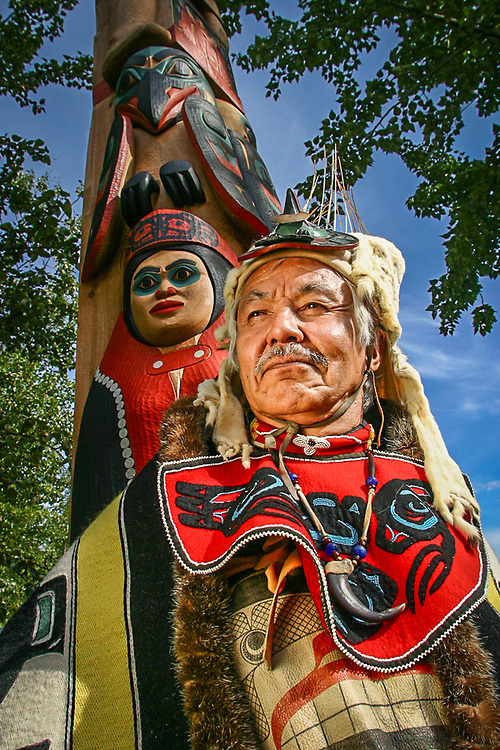
24 Jan ACP Receives $25,000 NEA Grant to Support Project with Tlingit Artist Nathan Jackson
The Arts Council of Princeton is pleased to announce it has been approved by the National Endowment for the Arts (NEA) for a Grants for Arts Projects award of $25,000. This grant will support a project titled “Monumental Sculptures: Understanding the Totem Poles of the Northwest Coast”, a program honoring and celebrating the artwork of the Tlingit peoples of the Northwest Coast.
In total, the NEA will award 958 Grants for Arts Projects awards totaling over $27.1 million announced as part of its first round of fiscal year 2024 grants.
Known as Northwest Coast Formline Design, the totem poles of these indigenous Tlingit peoples captivate and intrigue visitors the world over. Having very little exposure to the depth and complexity of these artistic and cultural treasures on the East Coast, the ACP will commission Tlingit artist Nathan Jackson, National Heritage Fellow and United States Artist Fellow, to carve a 9-foot totem pole that will be installed on permanent display at the ACP. Ketchikan, Alaska native, Mr. Jackson is one of the world’s most accomplished totem-pole carvers and has created more than 50 totem poles on view across the world.
Mr. Jackson will begin this commission at the Edwin DeWill Carving Center in Saxman Native Village, Alaska, and, after shipment of the pole to New Jersey, will complete the carving at the ACP in 2024. During his stay in Princeton, Mr. Jackson will be featured in a series of events that include public carving demonstrations, panel discussions, student workshops, and a traditional dance performance. Mr. Jackson will have an allocated carving space at the ACP’s Paul Robeson Center for the Arts, open to the public throughout the week, and will offer designated carving demonstrations that involve opportunities for visitors to ask questions and engage in discussion.
“The NEA is delighted to announce this grant to the Arts Council of Princeton, which is helping contribute to the strength and well-being of the arts sector and local community,” said National Endowment for the Arts Chair Maria Rosario Jackson, PhD. “We are pleased to be able to support this community and help create an environment where all people have the opportunity to live artful lives.”
We are beyond thrilled and humbled to have the NEA's support for this very special project. We are honored to bring Mr. Jackson to Princeton to demonstrate the resplendence and power of Northwest Coast native art and culture. There is no one else like him, an artist of the highest caliber. Nathan Jackson is a true national treasure.
– Adam Welch, ACP Executive Director
About Nathan Jackson
Nathan Jackson was born August 29, 1938, into the Sockeye Clan on the Raven side of the Chilkoot-Tlingit tribe in southeastern Alaska. He learned tribal ways from his clan uncle and grandfather, Jack David. “He instilled in me a desire for fishing, and fishing was one of the things that I learned, and he taught me all that I know as a fisherman…. The only time that he sang songs was when we were going out to the fishing camp. And I’d be listening, but didn’t sing along or try to learn it. And then when it came time to learn the songs was only when we were participating in a Fourth of July parade. The Indian songs are pretty much family type songs.”
Art is an integral part of the Tlingit social system, which is made up of clans, and many of the design motifs of Tlingit art are generated from clan crests such as the raven, eagle, killer whale, and beaver. Others come from traditional stories. An accomplished traditional artist must know the meanings of these symbols and stories, and a totem carver must know the protocol involved in commissioning, carving, and raising a totem pole. Jackson is a traditional dancer and an esteemed bearer of Tlingit values as well as a master wood carver, metalsmith, and creative artist.
“Tradition is something that most people say is identity,” Jackson said. “So, the traditional way of life is something I identify with in the sense that it’s pretty hard to change those things that are deeply imbedded.”
After completing his military service in Germany in 1959, Jackson started carving miniature totem poles during a bout with pneumonia that diverted him from his commercial fishing activities. He discovered that he had a talent for carving and painting. He attended the Institute of American Indian Arts in Santa Fe, New Mexico, to hone his skills. Later he met Northwest carver Duane Pasco and was inspired to learn to use the adze in carving large pieces. His work eventually included large totem poles, wood panel clan crests, masks, canoes, carved doors, and small items such as formline bracelets in silver and gold. His work is found in many museums in the United States and abroad.
Jackson has been willing to share his work with others learning the Tlingit traditions. He has taught several apprentices through the Alaska State Arts Council’s Master Artist and Apprenticeship program; has offered workshops and demonstrations on many occasions throughout Alaska and the Northwest; and has represented his state at festivals around the country. In recognition of his work, the University of Alaska, Southeast, awarded him an honorary doctorate of humanities.
“I can’t say much for myself,” he once said. “I try to perfect my work and improve as I go along. My aim is to continue working and continue spreading my reputation as a carver and as an artist — as would a person who has any type of job.”

